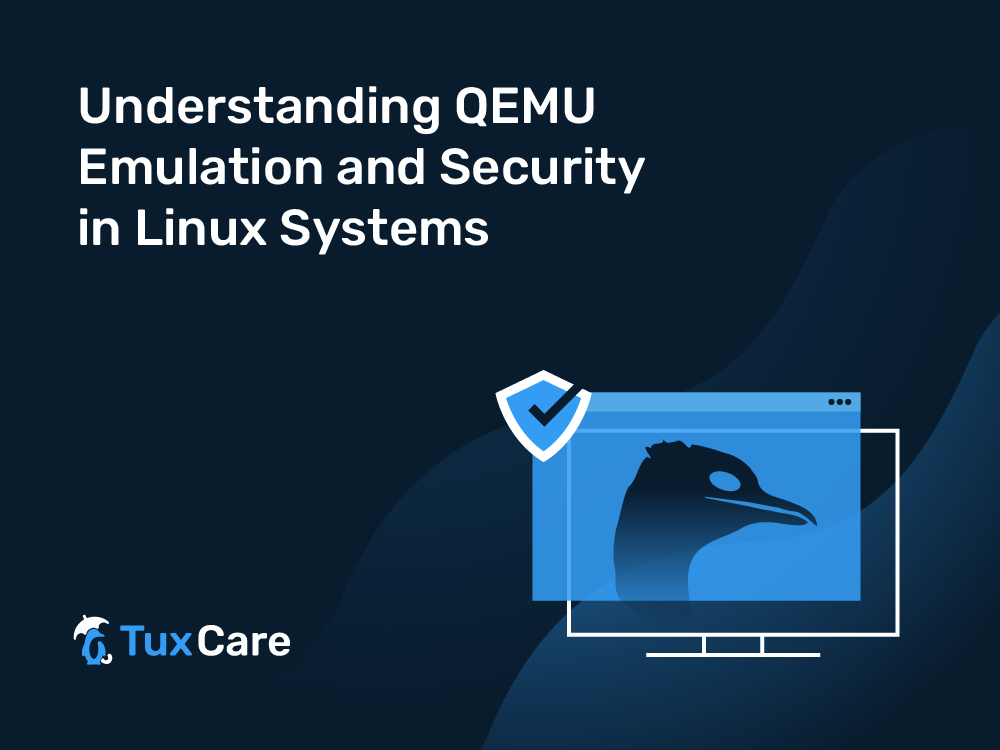Understanding QEMU’s Role in Linux System Emulation Security
- QEMU is mostly used for system-level virtualization and emulation.
- QEMU operates in both user mode and system mode.
- Automate patching with the QEMUCare live patching solution.
QEMU (Quick EMUlator) is an open-source emulator that enables users to run several operating systems on host systems. It is widely used for system-level virtualization and emulation, allowing users to run guest operating systems on different architectures. QEMU supports various architectures, including x86, ARM, MIPS, PowerPC, and more.
This article delves into the details of QEMU emulation, examining how QEMU emulates different systems on Linux and exploring its security implications. Additionally, it offers a comparative analysis with containerization technologies.
How QEMU Emulation Operates
Dynamic Binary Translation (DBT)
During runtime, QEMU utilizes a dynamic binary translation method to translate instructions from the guest architecture to the host architecture. This enables running guest operating systems on a host with a different architecture.
User and System Modes
QEMU uses both user mode and system mode. When operating in user mode, only the user-level code is translated. In system mode, the entire system, including kernel-level code is translated.
Emulation Modes
QEMU provides full system emulation and user-mode emulation. The full system emulation enables the operation of an entire OS on a virtual machine. Meanwhile, the user-mode emulation is used to run certain applications compiled for a different architecture.
Device Models
The guest OSes can interact with virtualized hardware through emulated device models provided by QEMU. This includes emulated CPUs, disk drives, network interfaces, and other peripherals.
Security Aspects of QEMU
QEMU emulation supports various use cases regarding security to maintain the safety and integrity of the virtualized environments. Here are some key aspects of QEMU’s role in Linux system emulation security.
Isolation of Guest and Host Systems
QEMU enables isolating the guest operating system from the host. This feature is critical for security because it prevents potential security flaws or exploits in the guest system from affecting the host system.
Device Emulation Security
QEMU emulates a variety of devices, including input devices, network adapters, and storage controllers. It ensures that these emulated devices do not expose any weaknesses that could be used by malicious code running in the guest system.
Memory Management
QEMU handles the memory management for the guest system, ensuring that memory access is controlled and isolated. This prevents a guest system from accessing or changing memory areas outside its allocated space, improving overall system security.
Sandboxing
Running virtual machines in a sandboxed environment is possible with QEMU. Sandboxing helps restrict the resources and permissions for the virtualized instances, limiting the attack surface and potential impact of security incidents.
Integration with Security Technologies
SELinux and AppArmor can be used to enforce additional security policies and access controls on the virtualized environments. These security tools limit the QEMU process, preventing it from accessing processes and files on the host system that are unnecessary for QEMU’s operation.
Other Features
The security features in QEMU also include Address Space Layout Randomization (ASLR) and NX (No-eXecute) support. ASLR randomizes the memory addresses used by system components, making it more difficult for attackers to predict the location of specific functions or data. NX support prevents the execution of code in certain memory locations, minimizing the likelihood of potential buffer overflow attacks.
QEMU Emulation vs Containerization
Isolation Mechanism
Containers share the host OS kernel while achieving process and resource isolation through the use of namespaces and cgroups. A compromise in the kernel could affect all containers on the host. QEMU, on the other hand, uses more resources but offers a higher level of isolation since it creates a full virtual machine with its own kernel.
Resource Efficiency
Generally, containers are lighter and more efficient than QEMU-created virtual machines. Because containers share the host operating system kernel, they start up more quickly and use fewer resources.
Portability
Containers are renowned for their portability, as they encapsulate dependencies and run consistently across different environments. QEMU VMs may require more configuration and customization when moving between hosts.
Use Cases
QEMU emulation is suitable for situations needing a variety of architectures and complete OS emulation. Containers are well-suited for microservices, where lightweight isolation and rapid deployment are essential.
Final Thoughts
While QEMU emulation contributes significantly to the security of Linux system emulation, users should follow best and recommended practices, keep the software updated, and adopt new security measures at the host and guest levels to create a robust and secure virtualized environment.
To ensure the maximum protection of QEMU-based virtualization systems, you can implement TuxCare’s QEMUCare live patching solution. QEMUCare offers automated security patching without having to reboot or migrate your virtualization machine, enabling your team to keep its virtualization systems patched and compliant without sacrificing uptime.
Schedule a conversation with a TuxCare security expert to get started with QEMUCare for automated vulnerability patching.



 Documentation
Documentation Login
Login




